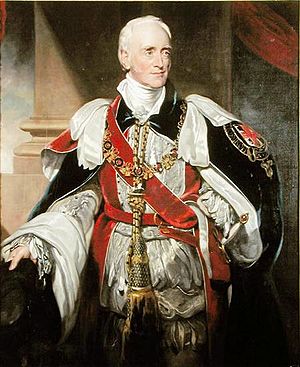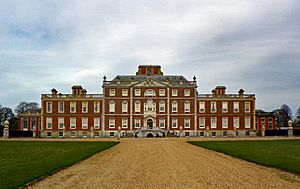Philip Yorke, 3rd Earl of Hardwicke facts for kids
Quick facts for kids
The Earl of Hardwicke
|
|
|---|---|

Lord Hardwicke in the robes of the Order of the Garter by Thomas Lawrence
|
|
| Lord Lieutenant of Ireland | |
| In office 27 April 1801 – 21 November 1805 |
|
| Monarch | George III |
| Prime Minister | |
| Preceded by | The Marquess Cornwallis |
| Succeeded by | The Earl of Powis |
| Member of Parliament for Cambridgeshire |
|
| In office 1780–1790 |
|
| Preceded by | Sir John Hynde Cotton, Bt |
| Succeeded by | Charles Philip Yorke |
| Personal details | |
| Born | 31 May 1757 Cambridge, Cambridgeshire |
| Died | 18 November 1834 (aged 77) |
| Nationality | British |
| Spouse | |
| Alma mater | Queens' College, Cambridge |
Philip Yorke, 3rd Earl of Hardwicke (born May 31, 1757 – died November 18, 1834) was an important British politician. Before 1790, he was known simply as Philip Yorke. He held several high positions, including being the Lord Lieutenant of Ireland. He was also a Knight of the Garter (KG), a member of the Privy Council (PC), and a Fellow of the Royal Society (FRS).
Early Life and Education
Philip Yorke was born in Cambridge, England. His father was Charles Yorke, who held a very important job as Lord Chancellor. His mother was Catherine Freman.
Philip went to Harrow, a famous school. Later, he studied at Queens' College, Cambridge, a university in Cambridge.
In 1790, Philip became the Earl of Hardwicke. He inherited this title and the family's large estates, including Wimpole Hall, from his uncle, Philip Yorke, 2nd Earl of Hardwicke.
A Career in Politics
Philip Yorke started his political journey early. From 1780 to 1790, he was a Member of Parliament for Cambridgeshire. He followed the political ideas of his family, who were part of the Whig group.
After he became an Earl in 1790, he changed his political support. He began to support William Pitt The Younger, who was a very powerful leader at the time.
In 1801, he took on a very important role: Lord Lieutenant of Ireland. This job was like being the King's main representative or governor in Ireland. He held this position until 1806. While in Ireland, he supported "Catholic Emancipation". This meant he believed in giving more rights and freedoms to Catholic people, who faced many restrictions at the time.
Philip Yorke was also given other honors. In 1801, he became a member of the Privy Council. This is a group of important advisors to the King or Queen. In 1803, he became a Knight of the Garter. This is one of the highest honors in Britain. He was also a member of the Royal Society, a group for important scientists.
Family Life
In 1782, Lord Hardwicke married Lady Elizabeth. She was the daughter of James Lindsay, 5th Earl of Balcarres. They had eight children together: four sons and four daughters.
Their children were:
- Philip Yorke, Viscount Royston (1784–1808): He was also a Member of Parliament. Sadly, he was lost at sea.
- Lady Anne Yorke (1783–1870): She married John Savile, 3rd Earl of Mexborough.
- Lady Catherine Freeman Yorke (1786–1863): She married Du Pre Alexander, 2nd Earl of Caledon.
- Charles Yorke (1787–1791): He died when he was very young.
- Lady Elizabeth Margaret Yorke (1789–1867): She married Charles Stuart, 1st Baron Stuart de Rothesay.
- Lady Caroline Harriet Yorke (1794–1873): She married John Somers-Cocks, 2nd Earl Somers.
- Charles James Yorke, Viscount Royston (1797–1810): He died at Wimpole from scarlet fever.
- Joseph John Yorke (1800–1801): He also died as a baby.
Lord Hardwicke passed away on November 18, 1834, when he was 77 years old. He was buried in St Andrew's Church in Wimpole, Cambridgeshire. His tomb was created by a famous artist named Richard Westmacott the Younger.
Since none of his sons lived longer than him, his nephew, Charles, became the next Earl. Lady Hardwicke lived a long life and died in 1858 at the age of 94.


